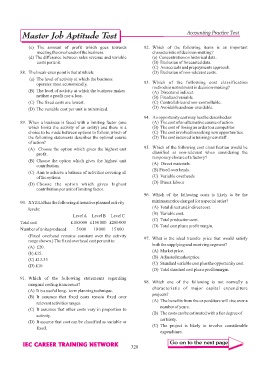Page 325 - GMAT 2017b_Neatb
P. 325
Accounting Practice Test
(c) The amount of profit which goes towards 92. Which of the following items is an important
meeting the overheads of the business. characteristic of decision-making?
(d) The difference between sales revenue and variable (a) Concentration on historical data.
costs per unit. (B) Exclusion of forecasted data.
(C) An accruals and prepayments approach.
88. The break-even point is that at which: (D) Exclusion of non-relevant costs.
(a) The level of activity at which the business
operates most economically. 93. Which of the following cost classification
methods is not relevant in decision-making?
(B) The level of activity at which the business makes (A) Direct and indirect.
neither a profit nor a loss.
(B) Fixed and variable.
(C) The fixed costs are lowest. (C) Controllable and non-controllable.
(D) Avoidable and non-avoidable.
(D) The variable cost per unit is minimized.
94. An opportunity cost may best be described as:
89. When a business is faced with a limiting factor (one (A) The cost of an alternative course of action.
which limits the activity of an entity) and there is a (B) The cost of losing an order to a competitor.
choice to be made between options to follow, which of (C) The cost involved in seeking new opportunities.
the following statements describes the optimal course (D) The cost incurred in training new staff.
of action?
95. Which of the following cost classification would be
(A) Choose the option which gives the highest unit
classified as non-relevant when considering the
profit.
temporary closure of a factory?
(B) Choose the option which gives the highest unit
(A) Direct materials.
contribution.
(B) Fixed overheads.
(C) Aim to achieve a balance of activities covering all
of the options. (C) Variable overheads
(D) Direct labour
(D) Choose the option which gives highest
contribution per unit of limiting factor.
96. Which of the following costs is likely to be the
minimum price charged for a special order?
90. XYZ Ltd has the following alternative planned activity
(A) Total direct and indirect cost.
levels:
(B) Variable cost.
Level A Level B Level C
(C) Total production cost.
Total cost £100 000 £150 000 £200 000
(D) Total cost plus a profit margin.
Number of units produced 5 000 10 000 15 000
(Fixed overhead remains constant over the activity 97. What is the ideal transfer price that would satisfy
range shown.) The fixed overhead cost per unit is:
both the supplying and receiving segment?
(A) £20.
(A) Market price.
(b) £15.
(B) Adjusted market price.
(C) £13.33
(C) Standard variable cost plus the opportunity cost.
(D) £10
(D) Total standard cost plus a profit margin.
91. Which of the following statements regarding
98. Which one of the following is not normally a
marginal costing is incorrect?
characteristic of major capital expenditure
(A) It is a useful long- term planning technique.
projects?
(B) It assumes that fixed costs remain fixed over
(A) The benefits from the expenditure will rise over a
relevant activities ranges.
number of years.
(C) It assumes that other costs vary in proportion to
(B) The costs can be estimated with a fair degree of
activity.
certainty.
(D) It assume that cost can be classified as variable or
(C) The project is likely to involve considerable
fixed.
expenditure.
328

